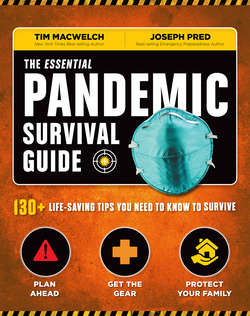Читать книгу The Essential Pandemic Survival Guide - Tim MacWelch - Страница 18
На сайте Литреса книга снята с продажи.
Оглавление12
10
11
basics
So if the experts are telling us that the coronavirus can live on cardboard for up to three hours and on plastic for three days, are we at risk from incoming packages? Well, your risk of being shot by a monkey with a zip gun is very very low, but it’s never zero. It’s never going to be zero. If you have that magical substance known as Lysol, you can blast each package on your doorstep before you bring it into the
house. You could also “quarantine” the packages in your
garage for a few days, washing your hands well after carrying them to the garage. The risk seems low that you’d bring the virus into your home on packaging, but the risk is never zero. What you should avoid, is dragging the boxes and bags into your home, hot off the truck, and cutting them open on your kitchen counter or dining table, and then forgetting to wipe down those surfaces with
disinfectant before you prepare or eat any food.
CHECK ONTHE MAIL
We don’t know how you feel about going to get groceries. Some people have always hated food shopping. For the homemaker types, it wasn’t so bad in former times. You’d push the cart through the store (bare handed!) and plan some meals that the family would like. You might buy a few days worth of food, bring the bags home and plop them right on
the countertop where the food is prepared.
Today, things are not so easy. At some point, the groceries in your kitchen are going to dwindle and you’re going to have to resupply. This means a trip to the grocery store, and possible exposure to the coronavirus. Even if you wear gloves and a mask in the store, many people have touched your food packages, which you have touched after touching the
shopping cart handle.
And don’t even remind us about the poor, beleaguered checkout worker, who has touched everything that has been handled by customers (both healthy and sick) and then touched each and every item you buy. This is why you need
to set up a decontamination station at home. Here’s how.
STEP 1 Pick a cleaning station. This should not be your kitchen table (where you eat the food) or your kitchen counter (where you prep it). We know folks who use a plastic table in the garage, which is perfect (easy to wipe down). For a simpler process, you can just organize and sanitize
everything on the front walkway.
STEP 2 Take everything out of the bags at your cleaning station. Get rid of disposable bags, and toss reusable bags in
the laundry to be washed with hot water and detergent.
STEP 3 Sort your groceries, according to the category container (or lack thereof) or by the “type” of food. Try lumping it into two categories, cold stuff and shelf stable,
safe stowing the cold stuff and perishables first.
STEP 4 Wipe down packaged products. You can use Lysol wipes to give your packages and products a quick wipe down. There’s no need to spray them with aerosol disinfectants. Save that for your household uses (like door knobs and toilet seats). Let the products dry before handling them again. Yes, cardboard and paper packaging will be a little messed up after a sanitizing wipedown, and if you don’t want that, there is an option for shelf stable products (things that don’t need to go into the fridge or freezer right away). Or, you can quarantine your products. Leave your shelf-stable products in the garage a few days, and any viral
organisms on their packaging will die.
STEP 5 Put it away. With clean hands, put away your disinfected products. If you have household helpers, they can take the items that have been wiped down (after the products dry). Or you can do it all. Either way, you are minimizing
your risks and that’s a beautiful thing these days.
BE SAFE ABOUT GROCERY SHOPPING
If you are out of Lysol wipes, make your own bleach wipe. Blend 2 teaspoons of bleach with 6 tablespoons of water, then apply this to a washcloth to wipe
down your products.
MAKE YOUR OWN WIPES
